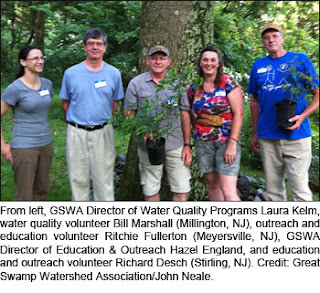Far-ranging geography game promotes awareness of nature, culture, history in northern New Jersey.
Morristown, NJ—On May 11, starting at 9:00 a.m., 18 area organizations and businesses will work together to present
The Great Swamp Scavenger Hunt—a free, outdoor event created by the
Great Swamp Watershed Association, and designed to promote greater public awareness of some of the most significant natural, cultural, and historical locations found in northern New Jersey.
Part game and part celebration, The Great Swamp Scavenger Hunt takes participants on a 40-mile adventure through the state’s Great Swamp Watershed region. This is the place where the mighty Passaic River rises, where George Washington’s troops survived the coldest winter of the Revolutionary War, where the U.S. government created the first federally-designated wilderness area east of the Mississippi, and where many seriously injured wild birds have found sanctuary and healing.
Scavengers spend a fun-filled day hunting down special tokens from more than 15 sites of interest throughout the watershed. Featured locations include the U.S. Fish and Wildlife Service’s
Great Swamp National Wildlife Refuge, the National Park Service’s
Morristown National Historical Park, Morris County Park Commission’s
Great Swamp Outdoor Education Center, Somerset County Park Commission’s
Environmental Education Center at Lord Stirling Park, New Jersey Audubon’s
Scherman Hoffman Wildlife Sanctuary,
The Raptor Trust, Harding Land Trust’s
Primrose Farms, the Great Swamp Watershed Association’s
Conservation Management Area, the Friends of the Great Swamp’s
Helen C. Fenske Visitor Center, Millington Gorge,
Meyersville Café, and the Rolling Knolls Superfund site.
“What a great event,” said Jenny Gaus-Myers, superintendent of environmental education at the Morris County Park Commission. “We love being part of the scavenger hunt and introducing lots of new visitors to our center and the wonders of the Great Swamp Watershed.”
Cathy Schrein, manager of Somerset County Park Commission’s Environmental Science Department, echoed Gaus-Myers’s sentiment, adding: “Events like The Great Swamp Scavenger Hunt and the Somerset County Environmental Education Center’s Swamp Search are such fun ways for the public to learn more about their immediate environment and to enjoy the outdoors.”
Geocaching enthusiasts will experience twice the fun at The Great Swamp Scavenger Hunt by logging special caches that have been carefully hidden at each location by members of Northern New Jersey Cachers (
NNJC.org)—one of the nation’s most respected geocaching organizations.
“NNJC has partnered with GSWA for a number of years, from boardwalk construction and kiosk building, to presenting a spooky Halloween hike,” said John Neale, president of NNJC. “Like geocaching, The Great Swamp Scavenger Hunt is another great example of getting folks together to enjoy the outdoors and learn about their local parks.”
At 4:00 p.m., scavengers will gather at Loantaka Brook Reservation’s
Kitchell Pond Pavilion (Morris Township) where they will be treated to a free picnic barbeque and will be able to exchange the tokens they collect for an opportunity to win one of several top-notch prizes.
This year’s prizes include premium outdoor gear and gift certificates to notable area restaurants donated by event sponsors at
Investors Bank of Madison,
Morris Tap and Grill in Randolph,
Meyersville Café in Long Hill Township, and
Shanghai Jazz Restaurant and Bar in Madison. Additional prizes and giveaways will be supplied by
Blue Ridge Mountain Sports in Madison,
Smarties Candy Company of Union Township, and other event partners.
“We want people to know that there is so much out there to see and learn in the Great Swamp,” said Liz Adinaro, head of marketing and media for Morris Tap and Grill. “We believe in supporting our community, as the community gives back to us by visiting our restaurant.”
Food for the Great Swamp Scavenger Hunt Picnic will be donated by event sponsors at
Whole Foods Market Rose City Madison, and
Costco East Hanover. Grills and buffet tables will be staffed by the Great Swamp Watershed Association and Northern New Jersey Cachers.
Scavenger hunters who choose to join the afternoon picnic are welcome to contribute a covered side dish to share with the rest of the group. Drinks, hot dogs, hamburgers, and an additional healthy main dish will be offered free of charge while supplies last.
Visit
GreatSwamp.org or call
973-538-3500 x22 for more complete information about
The Great Swamp Scavenger Hunt, including start time and location, a basic description of rules, and picnic details.
Online registration is free and recommended. Donations in support of the event are sincerely appreciated and may be made at time of registration or during the event at Kitchell Pond Pavilion.














